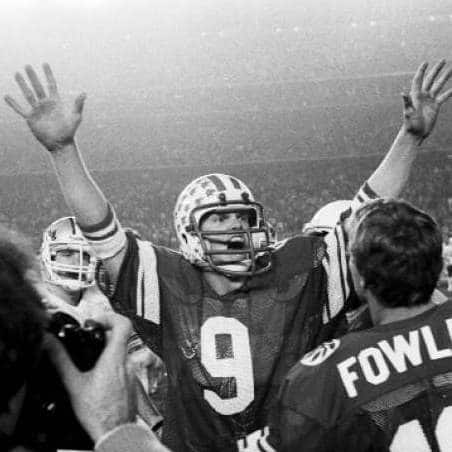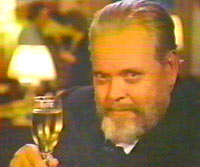I don’t intend to write exhaustively about the 1985 Bears,
but this game was so remarkable – and famous – that it is worth a review. For
one thing, it aired on a special Thursday night edition of Monday Night
Football, which they did a bit of back then. Aside from the Thanksgiving
games, there was another Thursday nighter in 1985, the week prior to
this one, plus a Friday night game in December between the Broncos and
Seahwaks, for some reason.
The game used ABC’s regular Monday Night Football team, which
for this season was Frank Gifford flanked by Joe Namath and O.J. Simpson – a couple
of real ladykillers there. This would be Broadway Joe’s only season in the
Monday Night booth. He wasn’t too bad, although he seemed reluctant to talk,
and usually contributed only when Gifford asked him to directly.
 Bears quarterback Jim McMahon had pinched a nerve in his
neck the previous week in the latter stages of a destruction of the Patriots,
and was considered for this game to be only the emergency quarterback. The emergency came in the third
quarter, with the Bears down 17-9 and backup Steve Fuller unable to put the
ball into the end zone. McMahon took over on the Bear 30, then stepped back and
threw a 70-yard bomb on the first play to Willie Gault.
Bears quarterback Jim McMahon had pinched a nerve in his
neck the previous week in the latter stages of a destruction of the Patriots,
and was considered for this game to be only the emergency quarterback. The emergency came in the third
quarter, with the Bears down 17-9 and backup Steve Fuller unable to put the
ball into the end zone. McMahon took over on the Bear 30, then stepped back and
threw a 70-yard bomb on the first play to Willie Gault.
While this play has become a key element in the Legend of Jim
McMahon, it ought to also have been a key part of the Legend of Walter Payton. The
Vikings middle linebacker was not only blitzing but had timed McMahon’s snap
count to the point that he was crossing the line of scrimmage as the ball was
snapped. Payton, lined up to next to McMahon in the shotgun, saw this happening
and cleared the linebacker out with a beautiful block. Without that block,
McMahon would have been sacked easily rather than hitting Gault in stride 40
yards downfield.
After the touchdown and a Wilber Marshall interception, the
Bears took over again, this time on the Vikings’ 25. On the first play from
scrimmage, McMahon rolled out and hit Dennis McKinnon crossing into the end
zone, into a window of opportunity that couldn’t have been more than about a
foot. It was a more difficult throw even than the Gault bomb. McMahon had now
been in the game for two plays and had thrown two touchdowns. Bears 23, Vikings
17.

Namath told a cute story about going to talk to Jim McMahon during the week, and having McMahon show up in an enormous neck brace that made it look like he’d never play football again. At the end of the interview, McMahon said the brace was just a joke and took it off, and everyone had a big laugh. Gifford, meanwhile, was just loopy. At one point, he said, “Jim McMahon has really fired this crowd up,” then realized the game was in the Metrodome, so just continued on with “or rather he has really quieted this crowd, partisan Vikings fans, of course.” ABC used to do this weird thing where, at the end of the third quarter, they’d show the first half stats, then dissolve into the third quarter stats. As soon as the first half numbers appeared, Gifford started talking about them as if they were up to the minute. He didn’t even try to cover up that mistake.
McMahon picked up a third TD pass in that third quarter, and
almost had a fourth when he connected with Dennis McKinnon down the sideline in
the fourth quarter for a 45-yarder, but Vikings safety Joey Browner came over
to save the touchdown. The Bears ended up coasting to a 33-24 win. Steve Fuller would go on to start four more games for the Bears that season, including the infamous Monday night loss to the Dolphins. McMahon would come on at the end of that one, too, but he was all out of miracles.












